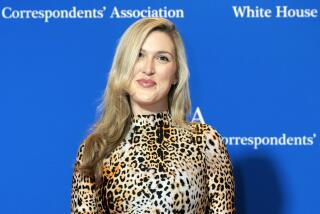Truth May Lose Out in Pursuit of a Sexy Read
A simple act--like standing in a checkout line to buy milk-- can make one dizzy with thoughts of sex. From the covers of women’s magazines, headlines scream: “Orgasm secrets revealed”; “100 ways to thrill a man in bed”; “How to be the sexually confident woman men love.” The sexual promised land is within reach, oh yes.
But what if the promises are empty? According to a story published this month in the Columbia Journalism Review, some women’s magazines change quotes, fabricate quotes, invent people and make wild extrapolations in stories about sex and relationships.
Last fall, Liza Featherstone, a New York City-based writer who wrote “Faking It: Sex, Lies and Women’s Magazines” for the CJR, was covering a panel discussion on the state of women’s magazines. Senior-level editors at women’s magazines and writers were in attendance when the discussion turned to the question of what ails women’s magazines. One editor proclaimed that the most egregious problem plaguing women’s magazines was not the reed-thin models nor flagging advertising revenues, but how much they “lie about sex.” The revelation drew nods and general agreement, Featherstone reported, but no denials.
“This is not happening at all women’s magazines, as I try to make clear in the article, but it is really a specific kind of lifestyle magazine that does a specific kind of anecdote-driven story within that genre,” said Featherstone, who cited Cosmopolitan, Glamour, Marie Claire, the now-defunct Mademoiselle, and other magazines that feature mostly sex and relationship advice stories. “These are usually how-to, instructive stories such as how to have much better sex or how to get your man to say you’re the best, but with the pretense that this is a reported story and the writer really went out there and investigated what women are really doing.”
Elle senior editor Laurie Abraham, the conference attendee who raised the issue of lying about sex, said in an interview that “massaging quotes,” as it is called in magazine parlance, is not the biggest lie. The deeper offense is how women’s magazines deliver sex and relationship stories in impossibly simplistic terms, such as “Jenny says that she makes her boyfriend happy by doing ...”
“The biggest problem is that these stories never get at the truth of what it feels like to have sex and at the ambivalence women have about sex,” said Abraham, who noted that Elle does not publish anecdote-driven relationship and sex stories, but plumbs the topics through personal essays. “This is not the crime of the century. But I don’t think you get to the truth in a roundup piece of interviewing 20 people and then stringing the anecdotes together.”
Editors come up with language on a magazine cover that reader research has shown sells magazines. The editors then assign a story to fill the “coverline,” said Abraham. “It is always the same thing, you know, 100 ways to skin a cat,” she added. “Everything is being forced into this chatty, magazine-y talk.” As a writer, Abraham herself had quotes changed. Years ago, she was assigned a story about “how to revive your sex life.” She quoted a friend who had been married for many years who had sex five times a week with her husband. “None of the editors could believe that anyone who is married has sex five times a week,” said Abraham, “so they changed it to three times a week.”
But Glamour Editor in Chief Cynthia Leive, who took the helm from Bonnie Fuller in May, strongly denied in the CJR article that quote embellishment occurred on her watch. “I can’t speak to the standards at all magazines, but most editors would be horrified to think that went on,” Leive told the CJR. Hearst Magazines, publisher of Cosmopolitan and Marie Claire, also disputed Featherstone’s charges. “We take offense with Columbia Journalism Review’s reporting,” e-mailed Paul Luthringer, vice president of communications for Hearst Magazines, when asked for a comment on the CJR piece last week. “Relationship stories are held to the same standards as all other stories. Every article is scrupulously fact-checked and all anecdotes in the magazine are to be accurate; composites are not allowed.” But Featherstone and others assert that quotes are changed to exaggerate or diminish sexually charged information in some women’s magazines, depending on a magazine’s image and readership.
Another writer, who has written for national women’s magazines for more than 15 years, said that besides changing facts in interviews, there is a general expectation that quotes will be rephrased in chatty tones consistent with a magazine’s voice. “Real people often are boring and real people are inarticulate,” said the writer, who added that if she interviewed someone very articulate she would sometimes divide that person into two or three people. “The magazine said that these quotes are flat, and I said, ‘Well, you wanted real people.’ So they told me to go back to interviewing my friends. If the quotes weren’t what they wanted, I changed them myself. One magazine once took opinions that I had expressed in a piece and attributed it to a psychologist.”
Another editor who has worked at women’s magazines for nearly 20 years said the quotes of experts who didn’t quite support the thesis of a story were routinely manipulated to say what editors needed them to say. “The editor had a concept for a story and if an expert’s quote didn’t work out, it was massaged by many editors to say what they wanted,” said the editor.
Pepper Schwartz, a University of Washington sociologist who is often quoted in women’s magazines, said she thinks many women’s magazines are guilty as charged. “Some social scientists won’t talk to the press because there will be just enough changes made to what they actually said that it will be wrong and it would be a professional embarrassment,” said Schwartz, who used to write a sex column for Glamour, where she said she was fact-checked better than academic journals under Ruth Whitney, then editor in chief. “When I was writing an article for one woman’s magazine and they changed something, I called the editor to say, ‘You can’t do this. I am a sociologist and this would be a trespass of principle and practice.” Schwartz said many women’s magazines refuse to include information about women’s sexuality that veers from what they deem normal or moral. “There was a magazine that would interview me ... and I was talking about what if a woman is seeing more than one man at a time. They said, ‘We can’t do that unless she is getting a sexually transmitted disease.’”
Writer Refused to Lie;
Story Was Killed
Even the personal essay is not immune. “I wrote an essay about a friend of mine I had been vaguely dating in college who had a sex-change operation,” said San Francisco-based writer Laura Fraser. “The senior editor who assigned it loved it and the top editor said, ‘You didn’t explore the feelings of betrayal and disgust deeply enough.’ I said, ‘I didn’t feel disgust or betrayal.’ I had a lot of other feelings that were complicated but not disgust and betrayal.” Fraser refused to lie about her emotional response to her friend’s operation and the piece was killed. Magazine editors and writers told Featherstone that lying about sex had to do with deadline pressure, the need to fill magazine pages and, curiously, to make sex stories seem more “realistic.” Sex stories were held to a different standard than other stories, editors, writers and fact-checkers told Featherstone. “I think that the wild extrapolations and inventions of people, inventions of quotes and the extent of fabrications doesn’t go quite to the extreme that it does with topics of sex,” said Featherstone. “Fact-checkers were often told by editors not even to bother to check a sex story, or they were told by an editor: ‘Don’t even bother calling that person because they don’t even exist.’” Are some of the journalistic prevarications of this sort a violation of readers’ trust?
“Lies, inventing quotes and making things up are disturbing things to readers....How can they trust these magazines to help them build a better sex life?” asked Bryce Nelson, a journalism professor at the USC Annenberg School for Communication. “The idea that sex has consequences in terms of emotional impact, pregnancy or sexually transmitted diseases is little dealt with in the women’s magazines.” But perhaps readers understand that stories such as “Ten Steps to Driving Your Man Wild in Bed” are not to be taken too seriously. Samir Husni, a professor of journalism and head of the magazine writing program at University of Mississippi, said readers deserve more credit for discriminating between fiction and reality.
“If you take the magazine as a whole, there are some well-reported stories,” said Husni, whose daughter works for Cosmo Girl. “Part of what [these] magazines do is give readers fantasy,” said Husni. “When a reader reads a quote, they read it with more salt than pepper. They read it for the fun, giggle and being in on the joke. Women want to read something that makes them feel good. These magazines are not there to make women feel guilty or bad.”


